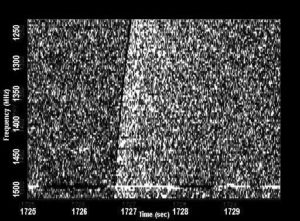
Observation of the first detected fast radio burst as described by Lorimer et al. (2007). Note that this is the brightest detection, processed for clarity. See image explanation at wikibooks.org.
Fast Radio Bursts were first seen in recorded images.
Fast radio bursts (FRBs) were first seen radiotelescope images such as the above. They are very bright, short (millisecond-duration), single pulses, curving through an image of sky. Finding an FRB long after it has occurred means the likelihood of identifying its source is much diminished. And finding the first one on an image gave rise to questions of whether it had occurred at all or was perhaps the result of a mechanical aberration of the telescope itself.
The first FRB to be discovered, in 2007, was so strange and singular an event, it took years for the community to agree that it was anything more than an instrumental glitch. Known as the Lorimer burst, the signal lasted only 5 milliseconds, but the radio emission was stretched across a wide range of frequencies, indicating that interstellar plasma had dispersed the radiation in the same way a prism can spread out visible light into a rainbow. This suggested a truly cosmic origin for the burst — in order to be so highly dispersed, the signal must have passed through millions or even billions of light years of intergalactic clouds.
For years, however, the Lorimer burst was in a class of its own. The second FRB wasn’t found until 2012, and that one only in archival data from the Parkes Radio Telescope, the same telescope through which the original burst was seen. When a few more bursts were seen at Parkes, through careful examination of real-time data, it became clear that whatever FRBs might be, they really were happening, and often. Early estimates of an event rate suggested there could be 10,000 bursts per day, occurring randomly in the sky, and blinking out quickly that they would be very easy to miss. The fact that only Parkes had ever seen an FRB was still troubling, though. Perhaps it really could be just some kind of instrumental glitch.
So it came with some relief to the astronomical community when, in early April, astronomers saw a burst with the giant Arecibo radio dish in Puerto Rico. This burst seemed consistent with the six already seen by Parkes, suggesting it was another glimpse at a new kind of astrophysical event. The question remains, however: what is it?
See the rest of this article at www.planetary.org.
Image Attribution: By Psr1909 (Own work) via Wikimedia Commons
To see the giant Arecibo radio dish in Puerto Rico, visit the next page.
